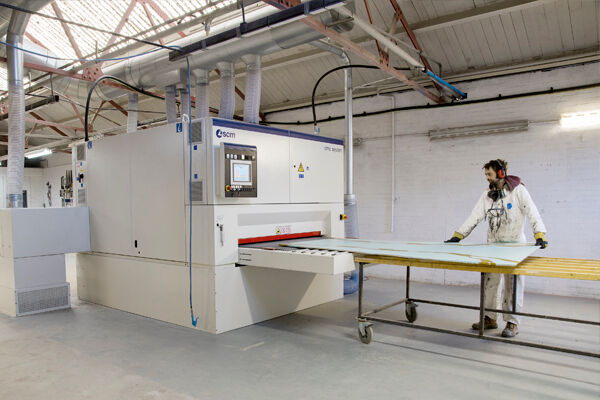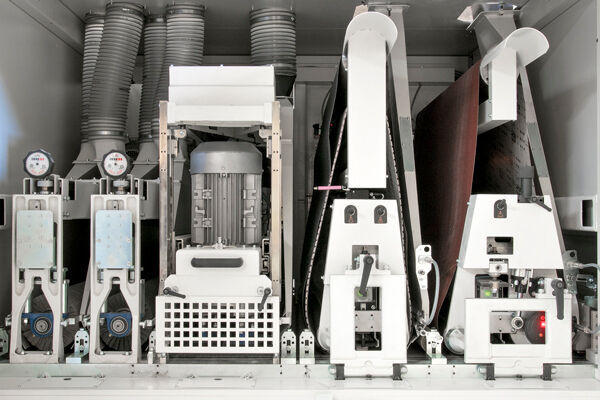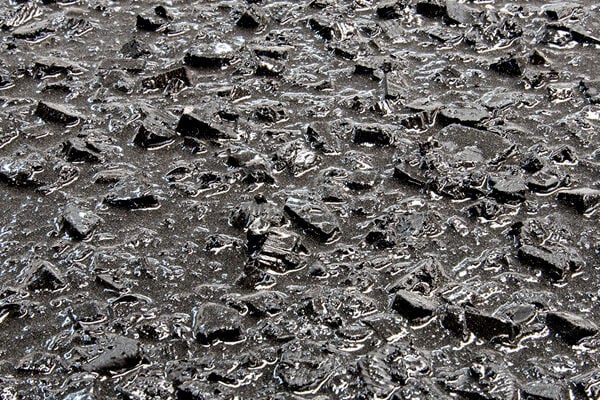
FABULOUS FINISHING
Jake Solomon is pushing his custom-built dmc system t4 sander to the max, producing subtle surface finishes on pioneering panel products that include resin, cement, rock and wood. Solomon & Wu make some of the most remarkable panel products I’ve ever come across.

Cast in a mould using a water and fire-resisting mix of cement and resin, they can include anything from metal powders or woodchips to recycled plasma rock. And as you might imagine, calibrating a panel that contains cement, resin and rock is far from easy, especially when the panels can be up to 3.6 metres in length and over 1600mm wide.
By hand, it’s a long, hard job that has to be done in stages and takes many hours. By machine it’s faster, but getting the right finish when the surface is peppered with materials of different densities and the natural cracks and crazing that form in the resin need to be retained is pretty much impossible for a typical calibrating sander.

But, after months of searching for a machine that would cope with the extreme demands of finishing his pioneering materials – and preserve their all-important character - Managing Director Jake Solomon has a smile on his face. He’s taken delivery of a new, purpose designed and built dmc system t4 1650 from SCM, and he’s absolutely delighted with the results it’s giving him. “When we make a panel, we can do it in several ways,” explains Jake. “Sometimes we take a substrate like ply (or we can start without a substrate) and we pour a pattern onto it. It’s never going to be a controlled pattern because resins catalyse in different ways, but that’s the beauty of it. The liquid panels are just cured resin that we have to sand through and finish. For the cast panels, we make a mould and pour the mix in. If we use metal powder, the metal drops through to the face so when you flip the panel over and put it through the machine, you get a sanded and polished metallic surface with lots of character. We also have stencil designs where we laser cut a stencil and pour resin around it”.
Solomon & Wu’s inventiveness is no respecter of traditional boundaries. If a client wants a particular effect, Jake and his team will set about creating it. “We recently bought an industrial level bandsaw to cut wood and a chipper to chip it so we could create panels using wood chips to create the design, then we designed a binder to hold it together.
We create a slurry of resin with wood chips or other materials, pour it on the board, vibrate it on a vibrating table, push out the air bubbles and sand it. We’re also using plasma rock in a mix of resin and cement. The problem is, resin is soft, plasma rock is hard. It’s immensely difficult for any machine to sand the two together, and nearly impossible to do so without losing the surface character. “The problem with most of the sanding machines we saw is they’re great for sanding flat things that need to be perfectly flat, whereas a lot of our stuff doesn’t need to be flat, it just needs to be done properly.
What drew me to this particular sander – the dmc system t4 – is that Fabrizio and Bruno in Italy didn’t try to sell us an off-the-shelf machine. They took the time to understand our materials and what we wanted to achieve, then they created a machine that would allow us the flexibility to finish a large range of materials.

We sent 12 full-size boards over to Italy, then another eight later on. It always looks different when you test a section, so I wanted to see full size boards going through. When I went to Italy, Fabrizio Pigato (from dmc’s technical lab in Thiene) gave me a really good understanding of what the different units are designed for and how we could adapt them to use with our products. He was fantastic to work with, very knowledgeable, and his advice was invaluable. SOLOMON & WU - UK 95 “The problem is we don’t want too much pressure, or too much finishing.
With the dmc, the calibration roller can lift and become a pad sander and we also decided on a superfinishing unit. We have planetary sanders that can be brushes or sanding discs. The spongy pads don’t put too much pressure on the material and they ride the surface rather than making it totally flat.

That’s perfect for our kind of work because we want to retain the texture. With our metallic panels, we want to clean a couple of millimetres of relief, so we put two longitudinal brushes on. The pad sanders then go into the crevices and bring out the grit, polishing the interior and the top so the product is much cleaner than we could ever have achieved by hand with a blue wheel and drill. Two passes and it’s a million times better than we could ever do it. “We had the machine specially widened to 1650mm to cope with our larger panels and opted for the heaviest calibration system we could get on the wider machine.
We also had a few other extras, like double vacuum to deal with bowing in boards and a brush system in the planetary sander.” Jake also added a cross belt and two Tynex brush attachments to the final specification, which, he admits, delayed the delivery, but now it’s installed and working, he’s delighted with the finish it’s producing and the ease with which he can change from one finish to another.
“The really great thing about the dmc is we don’t have to take units out and change things over, it’s all in there. Everything we need is built into the machine and operated from the program. We can pull the planetary sander out and change the brushes or the sanding pads if we want to and, of course, from time to time we need to change the belts, but that’s all. It takes only minutes to set the machine up, or change over from sanding one type of material to another, whereas the other systems we saw had removable heads that cost £15,000 each and we’d have had to move them in and out manually to achieve the same effect. That takes time. I want my people making beautiful things not working as engineers. With the dmc, everything stays in the machine all the time, unless it’s worn out.”
With such an extraordinary range of materials to finish, it was always going to take a while and a lot of experimentation with the different combinations the dmc incorporated before Jake and his team would be fully versed in the best way to set the machine up. “When Adolfo came over from Italy to train us, he was fantastic,” recalls Jake. “He told us why things do what they do and how you can play with the machine to achieve different results. He managed in seconds what we still take much longer to achieve but we’re getting there.
Ultimately, we have to play with it. It’s a machine with a huge amount of potential. It’s made a massive difference to our business.” In fact, it’s made so much difference to both the finish of his products and his company’s production capacity that Jake is already talking about buying a second dmc so he can ramp up his production still further. Melvyn Earle for Furniture Journal.
Credits: Melvyn Earle, Editor Furniture Journal
Fill out the online form to be contacted by a salesperson